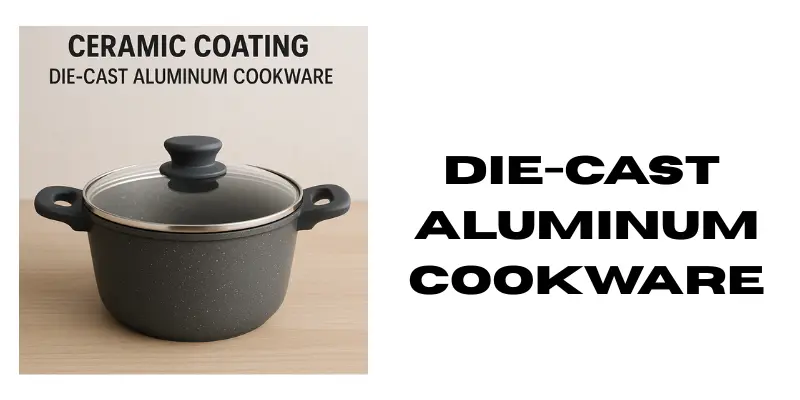Die-Cast Aluminum Cookware: Ultimate Guide to Benefits & Selection
Updated: 18 Jun 2025
155
Die-cast aluminum cookware provides exceptional heat distribution and lightweight handling, making it ideal for everyday cooking tasks. However, it requires protective coatings to prevent aluminum leaching and isn’t suitable for high-heat searing.

For most home cooks, die-cast aluminum offers the best balance of performance and convenience. This guide reveals when it’s the perfect choice – and when you should consider alternatives.
What is Die-Cast Aluminum Cookware?
Die-cast aluminum cookware is made by forcing molten aluminum into steel molds under high pressure. This manufacturing method creates:
- Seamless construction: No welded joints that can weaken over time
- Precise thickness: Uniform material distribution for even heating
- Complex shapes: Allows for ergonomic handles and integrated lids
How It Differs from Traditional Aluminum
Unlike stamped or spun aluminum, die-cast cookware:
- Has thicker walls for better heat retention
- Features reinforced edges and handles
- Offers superior durability and warp resistance
Performance Analysis: Pros and Cons
Key Advantages
- Superior heat conduction: Heats 3x faster than stainless steel
- Lightweight: 60% lighter than cast iron alternatives
- Even heating: Eliminates hot spots for consistent cooking
- Responsive temperature control: Adjusts quickly to heat changes
Important Limitations
- Reactive surface: Requires non-reactive coatings
- Temperature limits: Not suitable for high-heat searing
- Coating durability: The Surface can scratch with improper care
For tasks requiring quick heating and temperature control, die-cast aluminum outperforms most alternatives. For high-heat searing or oven use, consider cast iron or stainless steel.
Buying Guide: How to Choose the Best
Critical Selection Factors
Coating Type:
- Hard-anodized: Most durable, oven-safe
- Ceramic Cookware: Non-toxic, easy to clean
- Traditional non-stick: Affordable but less durable
Thickness Standards:
- 3mm: Good for everyday use
- 4-5mm: Professional quality with better heat retention
Compatibility:
- Induction-ready models have magnetic bases
- Oven-safe limits (check handles and lids)
Recommended by Cooking Style
| Cooking Needs | Recommended Features | Best For |
| Everyday family cooking | Ceramic coating, 3mm thickness | Quick meals, eggs, vegetables |
| Professional kitchens | Hard-anodized, 4-5mm thickness | Sauces, delicate proteins |
| Health-conscious cooks | PFOA-free coating, stainless steel lid | Low-fat cooking, steaming |
Professional Usage Tips
Best Practices
- Preheat properly: Medium heat for 2 minutes before adding food
- Use appropriate tools: Wooden, silicone, or plastic utensils only
- Clean gently: Hand wash with soft sponge and mild detergent
- Storage: Use pan protectors to prevent scratching
Common Mistakes to Avoid
- High heat: Never exceed 500°F (260°C)
- Metal utensils: Causes permanent coating damage
- Abrasive cleaners: Destroys non-stick surfaces
- Rapid temperature changes Can warp the cookware
Material Comparison
Here is the comparison of different cookware materials:
| Feature | Die-Cast Aluminum | Stainless Steel | Cast Iron |
| Heat Conduction | Excellent | Poor (requires aluminum core) | Good |
| Weight | Light | Medium | Heavy |
| Durability | Good (with proper care) | Excellent | Excellent |
| Maintenance | Medium | Easy | High |
| Best For | Everyday cooking, sauces | Searing, deglazing, all-purpose | High-heat searing, oven use |
Choose die-cast aluminum for responsive heat control, stainless steel for durability and searing, and cast iron for high-heat cooking and oven use.
Expert Answers to Common Questions
1. Is die-cast aluminum cookware safe for health?
Modern die-cast aluminum cookware with intact coatings is completely safe. The protective layer prevents aluminum from leaching into food. Look for PFOA-free certifications for additional safety assurance.
2. Can I use metal utensils on die-cast aluminum cookware?
Only with hard-anodized coatings specifically rated for metal utensil use. Traditional non-stick and ceramic coatings will scratch and degrade with metal utensils. Always check manufacturer recommendations.
3. How do I clean discolored aluminum cookware?
Create a paste of 2 tablespoons baking soda and 1 tablespoon vinegar. Apply to the surface and let sit for 15 minutes. Gently scrub with a soft sponge, then rinse thoroughly. Avoid abrasive cleaners that can damage coatings.
4. Is die-cast aluminum cookware oven-safe?
Many hard-anodized aluminum pieces are oven-safe up to 500°F (260°C). Always check manufacturer specifications as handles and lids may have lower temperature limits. Traditional non-stick coatings typically have lower heat tolerance.
5. Why does my aluminum cookware warp on the stove?
Warping occurs from thermal shock – sudden temperature changes. Always preheat gradually and avoid placing hot pans in cold water. Higher quality die-cast aluminum with proper thickness (4mm+) resists warping better.
Final Recommendations
Choose die-cast aluminum cookware if:
- You prioritize fast, even heating for everyday cooking
- Lightweight handling is important to you
- You cook primarily on medium heat
Invest in quality hard-anodized pieces for best results, and always follow manufacturer care instructions to extend your cookware’s lifespan.
Please Write Your Comments